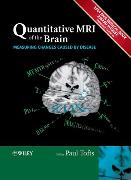- Start
- Quantitative MRI of the Brain - Measuring Changes Caused by Disease
Quantitative MRI of the Brain - Measuring Changes Caused by Disease
Angebote / Angebote:
The MRI machine is undergoing change in how it is used. Used conventionally, it produces images, which are viewed qualitatively by radiologists. Unusually dark, light, large or small areas are noted, and subtle changes cannot be detected. In its new use, that of a scientific instrument making measurements in the human brain, a myriad of physical and biological quantities can be measured for each small voxel of brain, of dimensions typically between 1-3 mm.
The book opens with a section on concepts which explores the principles of good practice in quantification, including quality assurance, MR data collection, and analysis aspects. Current limits are discussed in detail, and solutions proposed. A chapter on each of the major physical quantities follows (including proton density, T1, T2, diffusion, magnetisation transfer, spectroscopy, functional MRI and arterial spin labelling). The physical principles behind each quantity are given followed by their biological significance, practical techniques for measuring the quantity imperfections that can arise in the measuring process, and an extensive survey of clinical applications of that quantity. The pathological correlations with the MR quantities are discussed.
This is an indispensable 'how to' manual of quantitative MR, essential for anyone who wants to use the gamut of modern quantitative methods to measure the effects of neurological disease, its progression, and its response to treatment. It will appeal to research-minded radiologists, neurologists and MRI physicists who are considering undertaking quantitative work, as well as those already in the field.
Professor Paul Tofts has worked on the physical aspects of quantitative brain imaging since the early days of clinical NMR. He was the first to measure in-vivo concentrations of metabolites, and to use dynamic imaging to measure blood-brain barrier permeability and extra-cellular space in multiple sclerosis.
"Paul Tofts has succeeded brilliantly in capturing the essence of what needs to become the future of radiology" - from the Foreword by Robert I Grossmann, M.D., Louis Marx Professor and Chairman, Professor of Radiology, Neurosurgery, Neurology, Physiology and Neuroscience, New York University School of Medicine
Folgt in ca. 15 Arbeitstagen
